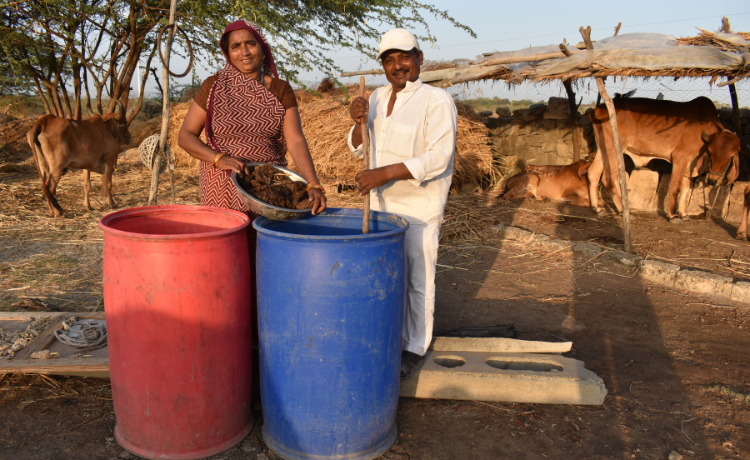Once daily-wage labourers in stone mines and fields, Jashuben and Manubhai lived a life of hard labour and uncertainty. Their farm struggled with low productivity, poor groundwater, and dependence on monsoons. Making ends meet was a constant battle. But those days are long behind them. Today, Jashuben stands tall as a successful micro-entrepreneur, respected community leader, and mentor to other women.
With support from Ambuja Foundation and Better Cotton, Jashuben embraced new knowledge, and tools - evolving from labourer to co-farmer to entrepreneur in the last three years.
1. Embracing Modern Farming Practices - After training under the Better Cotton programme, Jashuben adopted climateresilient practices like intercropping, mixed and relay cropping, reduced tillage, and alternate irrigation. She used pheromone and sticky traps to monitor pests and cut down chemical use— leading to healthier soil and better yields.
2. Producing and Selling Bio-Inputs - Jashuben joined a women’s farmer group and was trained in making homemade bio-inputs (bio-fertilisers & bio-pesticides) like Neem Ark, Agni Astra, Jeevamrut and Ghan Jeevamrut. As group leader, she began using these on her own crops—leading to reduced costs and boosting sustainability—and now sells these products to other farmers. Inspired, five village women have joined the farmer group, and are mentored by Jashuben.
3. Diversifying into Livestock & Dairy - Understanding the value of multiple income streams, Jashuben took a loan of Rs. 1,00,000 to buy a buffalo, cow, and calf. Selling six litres of milk daily to the local dairy, she earns Rs. 4,000 every 10 days – providing financial stability.
4. Water Management & Future Plans - To address drinking water scarcity and optimise irrigation, Jashuben and her husband installed drip irrigation on their five-bigha land. This inspired their neighbours to follow suit and has improved their water use too. She now plans to build a farm pond for rainwater harvesting and install a rooftop rainwater harvesting system (RRWHS) for household needs.
5. Multiple Income Streams - Where the family once earned just Rs. 5,000–Rs. 6,000 a month, they now generate Rs. 30,000 - Rs. 40,000 from agriculture alone. From selling Rs. 30,000 worth of bio-inputs with Rs. 20,000 in profit, to dairy earnings of Rs. 30,000 - Rs. 40,000, Jashuben’s income is as diverse as her skills. Revolutionary steps Multiple Income Streams Diversifying into Livestock & Dairy Producing and Selling BioPesticides Water Management & Future Plans Embracing Modern Farming Practices Case stories.
Her transformation has not gone unnoticed. Admired by her in-laws and community, Jashuben is now a role model. With her mentorship, a quiet revolution is taking root—one where women are reclaiming their roles as farmers, entrepreneurs, and leaders.







